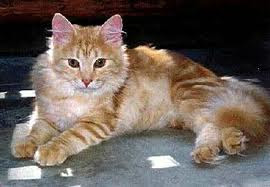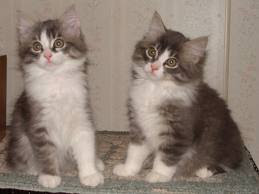Turkish Angora Cat
History of Turkish Angora Cats
 |
| Turkish Angora Cat kittens |
The Turkish Angora Cats have descended from the African wildcats. Traders from Egypt brought cats into Eastern Anatolia, where through natural choice and inbreeding, the Turkish Angora was developed along with the Turkish Van. The Turkish Angora was brought into Europe where it was brought almost to extinction in trying to improve the coat of the Persian cat. Today, the Turkish government runs a breeding program to preserve their national treasure.
Types of Turkish Angora Cats
 |
| Turkish Angora Cat |
You'll find no specific types of Turkish Angora Cats.
Physical Attributes of Turkish Angora Cats
The Turkish Angora have a silky longhaired coat, originally white. Nowadays, there's a massive range of colors in Turkish Angora cats which includes black, red, blue, lavender, smoke, and so on. The eyes of the Turkish Angora cats are blue, green or amber. Some Turkish Angora cats, nonetheless, could possibly be odd-eyed- i.e they've 1 blue eye and also the other green or amber. Their eyes are almond shaped and their ears are long and pointed. Their tail is plumed and they generally carry it upright, perpendicular to their backs.
Personality of the Turkish Angora Cats
 |
| Turkish Angora Cat |
The Turkish Angora cats are regarded as dog like in numerous aspects. They are outgoing, friendly and people-friendly. They're also playful and like the attention of individuals.
Caring for Turkish Angora Cats
 |
| Turkish Angora Cat |
Turkish Angora Cats need to have minimal grooming, except regular brushing due to the fact they're longhaired. It is essential to make sure common brushing specially in the course of summer months when they're shedding. Also, Turkish Angora cats are prone to deafness and genetic illnesses like Ataxia and Hypertrophic Cardiomyopathy.
 |
| Turkish Angora Cat |
The Turkish Angora (Turkish: Ankara Kedisi) is really a breed of domestic cat. Turkish Angoras are 1 of the ancient, naturally occurring cat breeds, getting originated in central Turkey, inside the Ankara (historically called Angora) region. The breed is also from time to time referred to as merely the Angora or Ankara cat, and in some obsolete works as the Angola
Physical characteristics
 |
| Turkish Angora Cat |
Turkish Angora Cats have a silky tail, medium-long length coat, no undercoat and fine bone structure. There seems to be a connection among Ankara Cats and Persians (see below), and also the Turkish Angora is also a distant cousin of the Turkish Van. Despite the fact that they are identified for their shimmery white coat, presently there are actually a lot more than twenty varieties which includes black, blue, and reddish fur. They come in tabby and tabby-white, together with smoke varieties, and are in every color apart from pointed, lavender, and cinnamon. Eyes might be blue, green, or amber, or even 1 blue and 1 amber or green. The W gene responsible for the white coat and blue eye is closely related towards the hearing ability, and presence of a blue eye can indicate the cat is deaf towards the side the blue eye is situated. On the other hand, an awesome lots of blue and odd-eyed white cats have typical hearing, as well as deaf cats lead a very typical life if kept indoors.
 |
| Turkish Angora Cat Kittens |
Ears are pointed and big, eyes are almond shaped as well as the head is enormous having a two plane profile. One more characteristic will be the plumed tail, which is typically carried upright, perpendicular towards the back.
History
 |
| Turkish Angora Cat |
Like all domestic cats, Turkish Angoras descended from the African wildcat (Felis silvestris lybica) isolated cats brought by traders from Egypt[citation needed] and eastern mountainous regions of early Anatolia and by way of inbreeding specifically with (Felis lynx) and natural selection they developed into longhaired breeds like the Turkish Van plus the Turkish Angora[citation needed].
Longhaired cats had been imported to Britain and France from Asia Minor, Persia and Russia as early as the late 16th century, although you will find indications that they appeared in Europe as early as the 14th century on account of the Crusades. The Turkish Angora was applied, almost towards the point of extinction, to strengthen the coat on the Persian. The Turkish Angora was recognized as a distinct breed in Europe by the 17th century.
 |
| Turkish Angora Cat |
Within the early 20th century, the Turkish government, in conjunction using the Ankara Zoo, began a meticulous breeding program to protect and preserve what they regarded as a national treasure: pure white Turkish Angoras with blue and amber eyes.The program continues currently. The zoo particularly prized odd-eyed Angoras . Turkish Angoras with one blue eye and 1 amber eye).The Zoo has its own cat facility which houses the white Turkish Angoras for its breeding program.
The Turkish Angora, which was brought to the United States in 1963, was accepted as a championship pedigreed breed in 1973 by the Cat Fanciers' Association.Nonetheless, until 1978 only white Angoras had been recognized. Today, all North American registries accept the Turkish Angora in lots of colors and patterns. While numbers are still comparatively modest, the gene pool and base of fanciers are growing.
Well being considerations
Some Turkish Angora kittens suffer from ataxia, a rare condition which is thought to be inherited as an autosomal recessive.The kittens affected by ataxia have shaking movements, and do not survive to adulthood.
 |
| Turkish Angora Cat |
One more genetic illness that is rare but identified towards the breed is Hypertrophic Cardiomyopathy,which is actually a cardiac condition normally found between the ages of two - 6, with males becoming affected additional commonly and additional severely than females.
 |
| Turkish Angora Cat kittens |
In the Maine Coon cat, HCM is thought to be an autosomal dominant gene and researchers are working to identify markers for this disease. Nonetheless, inside the Turkish Angora, the disease has not but been studied at length primarily on account of its rarity of occurrence, and is most likely to result from a various mutation of genes, having a various gene location than that of the Maine Coon cat. HCM also affects several other breeds, which includes Ragdolls, to Persians and Bengals













